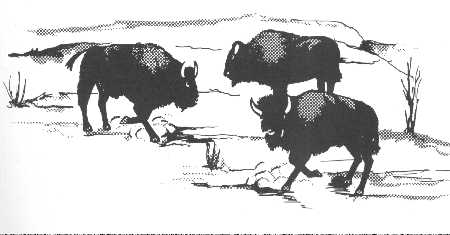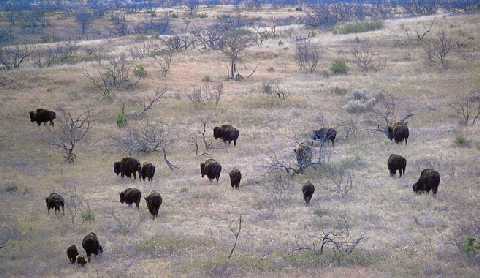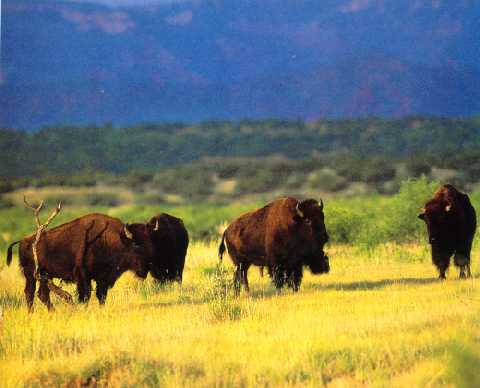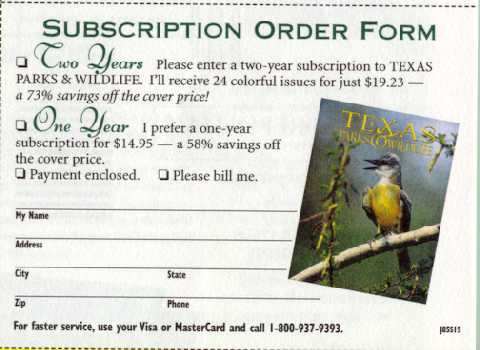
Great herds of wild buffalo once grazed the rich grasses around Odessa, Texas. The shaggy animals were the main source of food, clothing and shelter for the Indians who followed the herds deep narrow trails.

Great herds of wild buffalo once grazed the rich grasses around Odessa, Texas. The
shaggy animals were the main source of food, clothing and shelter for the Indians who
followed the herds deep narrow trails.
Along the trails, these magnificent animals left Buffalo Wallows that still exist for hundreds of miles across the plains. The wallows were created years ago when the mammoth animals pawed and rolled in the dirt to rid themselves of ticks and fleas. West Texas winds whipped the loose dirt away, creating basin-shaped depressions. Rainwater created water holes, an even more enticing place for the buffalo to drink and play; they covered themselves with a mud coat to cool off and keep the flies away.
There are a least two of these historic wallows in Odessa; one on East 42nd Street, has been offically marked by the State Of Texas.
The Buffalo herds were killed for their skins and their remains covered the countryside. Bones were stacked high along the railroad track awaiting shipment to the East for fertilizer and souvenirs. Pioneers collected bones to sell, adding to their livelihood during dry years. Buffalo chips were burned for camp fires.

"My muscles hardened...As far as the eye could reach, south, east and west of me
there was a solid mass of buffalo --- thousands upon thousands of them --- slowly moving
toward the north.
Billy Dixon on the Texas plains in 1874.
Few People today can fathom the sight beheld by this buffalo hunter on that spring day in the mid-19th century, only a few miles from the present town of Pampa, Texas. Dixon and a handful of others were spearheading the initial thrust of northern buffalo hunters into the Comanche hunting grounds on the Texas plains. In just two years they had decimated the big herd in Kansas. Now, with nothing between them and the great Texas herd but the Arkansas and Cimarron rivers, they began one of the greatest bison slaughters in history.
Fueled by the European demand for robes and industrial leather, the slaughter of the Texas bison herd began in earnest in the spring of 1874. By late 1878, buffalo hunters had killed more than 3.5 million of these animals across the Texas plains. When the big Sharps rifle finally fell silent, only a few hundred animals remained.
As the buffalo herds gave way to the hunters, ranchers moved their cattle herds onto the now-vacant range. Charles Goodnight, former Texas Ranger and buffalo hunter, established the JA Ranch in 1877 along the Mulberry and Palo Duro canyons in the Panhandle. Encompassing more than 100,00 acres of land and supporting thousands of cattle over the next decade, Goodnight's JA Ranch was destined to become one of the most renowned ranches in Texas history. A shrewd businessman who realized that the bison and the Comanche must give way to the tide of civilization, Goodnight also appreciated the buffalo and other wildlife native to the plains.
Foreseeing that the end was near for the Southern Plains buffalo, Goodnight secured more thatn 200 wild bison in a pasture designated solely for their safe keeping. Here, for more than a century, this last remnant herd of buffalo has roamed free over the JA and surrounding ranches of the Texas plains.
More than a century after Goodnight secured the herd, the significance of these animals to the state and the people of Texas sparked an interest by the Texas Parks and wildlife Department. This led to an agreement between the JA Ranch and TPWD for the capture and relocation of this unique herd to Caprock Canyons State Park in Quitique, Texas. On a crisp fall morning in 1997, two dozen TPWD employees began capturing the mighty animals. Despite the vagaries of the Panhandle weather, the free-ranging Southern Plains Bison --perhaps the last in the world--were captured and transported to the facilities at Caprock Canyons. Now, some two dozen Southern Plains Buffalo again will roam their native range to inspire all who appreciate the wild heritage of Texas.

Enjoy Articles like this with the "Texas Parks & Wildlife Magazine".
Subscribe on line by going to TP&WL
Web Site, and enjoy beautiful Photographs and Articles!

Texas Parks & Wildlife
1700 Ranch Road 12 STE A202
San Marcos Tx. 78666-9970
Courtesy:
The Texas Park & Wildlife Web
Site,
& The Odessa Exchange Club.
Clear this Page